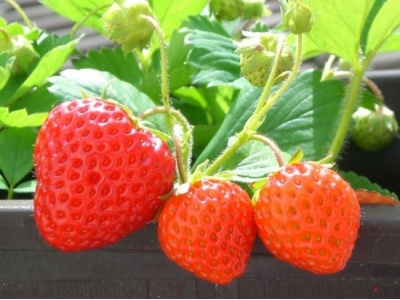6 Tips for Better Results Growing Strawberries

Strawberries are a versatile little fruit. From cereal/salad topper to smoothie flavoring to tart pastry filling, this is a fruit you can incorporate into breakfast, lunch, dinner, beverage, or dessert. In addition to packing a bounty of Vitamin C, you’ll also get 5% or more of your daily nutritional value of manganese, fiber, iodine, folate, copper, potassium, and biotin from just one cup of strawberries.
Strawberries are generally an easy crop to grow, but gardeners are always looking for bigger berries and a larger harvest. Compare your growing technique to these tips. What tips do you have to share?
1. Choose your strawberry plant wisely
Did you know that there are hundreds of strawberry varieties? Everbearing strawberries produce two harvests per year: one in the spring and one in late summer. These strawberries are best planted in hills or areas with limited space, since they spend more energy producing than expanding outward.
June-bearing strawberry plants are the most popular and common variety. These varieties rarely produce in the first year, so don’t be discouraged. When they do grow, they yield large strawberries over 3-4 weeks in June. But even this variety of plants is further classified into Early Season, Midseason, and Late Season. Plant classification is important to understand if you want to get the most berries from your plant.
Unlike June-bearing strawberries, day-neutral varieties will produce fruit in the first year. These berries are much smaller, averaging only about one inch. However, these plants are able to produce berries year-round when grown in temperatures between 35-85 degrees Fahrenheit.
2. Optimal soil conditions for strawberries
Now that you know the different plant varieties, let’s talk about optimal soil conditions. Strawberries work great in raised beds due to drainage, but not in soil that previously housed plants that strawberries dislike: tomato, potato, pepper, and eggplant. For best results, amend your soil with compost or aged manure and use alfalfa meal fertilizer.
3. Protecting strawberry plants from pests
Snails, slugs, earwigs, and sowbugs love to snack on strawberry plants. The best way to protect your plants is to cover the soil with a porous weed block material. Note that if you already have a pest problem, you should skip organic mulch since that will only attract these nuisances. Otherwise, straw is an effective mulch.
4. Watering your strawberry plants
The ideal method for watering strawberries is drip irrigation. This helps to keep water away from the fruit to reduce fruit rot. Because strawberries have shallow roots and the surface of the soil can dry out rather quickly in some areas, soil must be kept moist (not soggy) during the entire growing season. The optimal soil saturation is 1 inch.
5. Remove the runners
As painful as this may be, you must remove the runners. These are the long stems that come off of the main plant and make more strawberry plants. Why would you reduce your harvest in this manner? Because runners compete with your main plant for nutrients and your strawberry yield and size will suffer.
Test it out for a season and you’ll see the difference between allowing runners to grow or pinching them off at the central plant base. By removing the additional strawberry plants, you are ensuring that your plant produce more berries in the long run.
6. Strawberry plant placement
Perhaps the most often overlooked tip for growing strawberry plants. Strawberries need sun---and lots of it. The more sun your plants get, the bigger the strawberries will be. Don’t worry about scorching them unless temperatures reach over 85 degrees Fahrenheit (if so, you will want to shade them). Just keep the soil moist and the plants will thrive despite the constant sun. For this reason, strawberries are usually planted in rows, thus allowing the sun to penetrate the entire perimeter of the plant.
Có thể bạn quan tâm
 How To Make Vertical Garden In 6 Steps!
How To Make Vertical Garden In 6 Steps! If you are the owner of a very small site, then use this kind of cool idea. Build a vertical bed and the problem of lack of land will be solved! How to make
 How To Grow Cucamelon
How To Grow Cucamelon Add a bit of whimsy to your garden this year with an adorable cucamelon plant. This small plant is a delicate, yet strong vining one that produces dainty fruit
 How to Build a Strawberry Planter: Tips and Plans
How to Build a Strawberry Planter: Tips and Plans Strawberry planters are available at nurseries and by mailorder, but by building your own, you’ll save money and have a high-quality container that's custommade